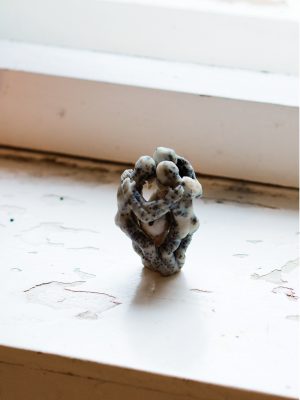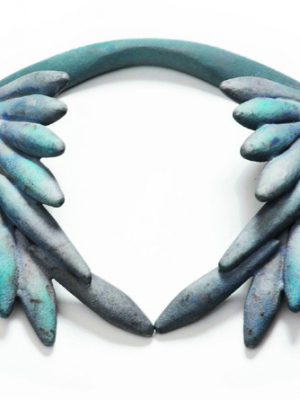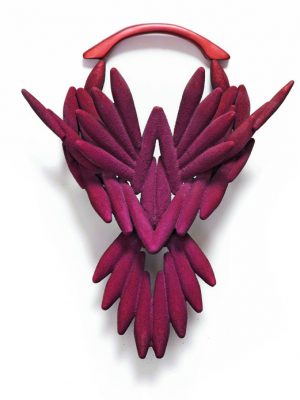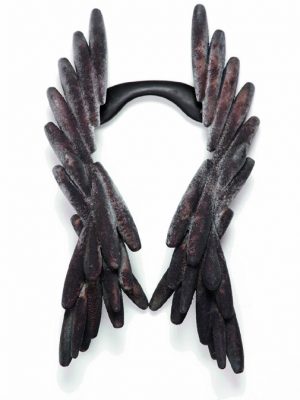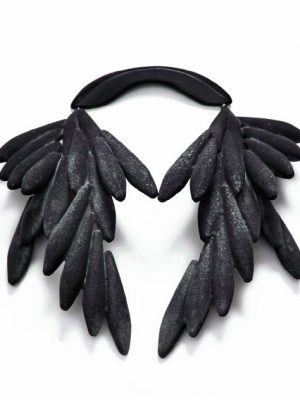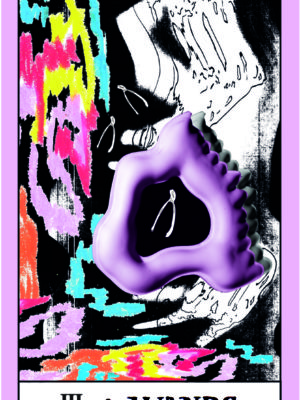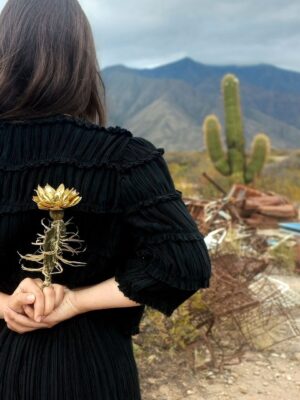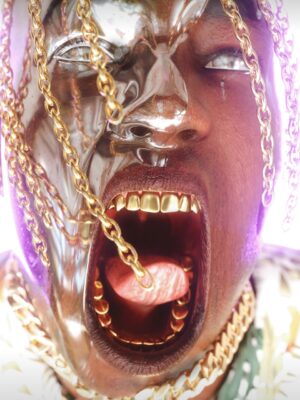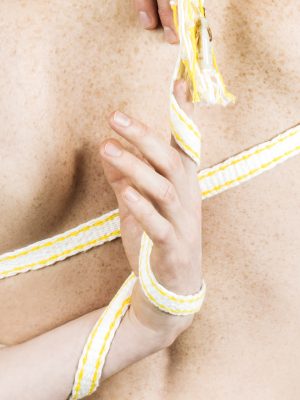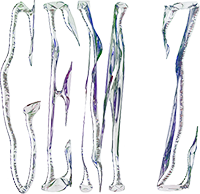Most things having to do with jewellery circulate around a large corner building in the center of Tallinn – Hobusepea 2. This enterprise of a building belonged to Joseph Kopf, a German man, who established a jewellery and silversmith company here in 1891. In it’s glorious past, it was swarming with workers who produced pieces in diverse workshops across the building and sold them in luscious jewellery shops on the ground floor. Now it is a maze of countless artist ateliers and living quarters, where gold and silversmiths carry on the tradition. Passages here are long and curvy; floors succeed each other through tight stairwells; original Kopf machinery is scattered across the building. The courtyard shows vertigo of windows with jewellers benches; balconies, stacked with materials, rusty metal objects and glass jars. It is a breathtaking anthill. Here and now is where Tallinn contemporary jewellery is made.
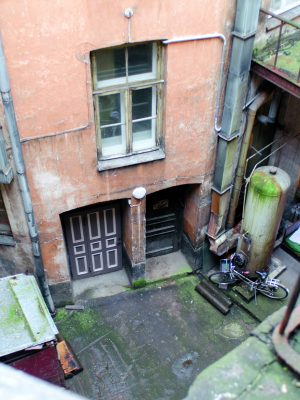
How did we end up here in the first place? Well, the work that comes out of Estonia is mesmerizing, dark and poetic in it’s own intangible way. I guess we just wanted to know more; more about who these makers are and why they have the tilt for the dark matters, masterfully twisting the story with wonderful unexpected turns. Academy of Arts has not been in its original dwellings for many years. Instead the Metal studies are being pursued in an old science institution, where the laboratory and libraries were located in the communist pat. There is a maze of nuclear hideouts, framed with thick metal doors, sitting deep in the guts of the building. If you pass the metal workshop, with all the hard cumbrous machines, acid cabinets and rusty-dusty tools and follow a dark narrow corridor, you will see a door to your right – it’s a sauna. People constantly use it, and this combination of spaces is striking: somehow it makes sense here! In a place, where people know about Polar Night firsthand and where it’s dark almost 8 months a year, sauna in the metal workshop of the Art Academy makes a lot of sense. ‘I think people are very deep here… Metal students considered being the heaviest drinkers in school. But you have to find a way to let it all out… There is a lot of suffering, but also a lot of joy…’ – says Bruno Lillements, former student, and now an independent maker. Bruno is showing us an abandoned rusty pool in the courtyard. It used to contain an enormous computer back in the soviet past. We are standing outside the Academy looking into the windows. He smokes and tells us stories. It’s already getting dark…
‘There is a lot of suffering but also a lot of joy’
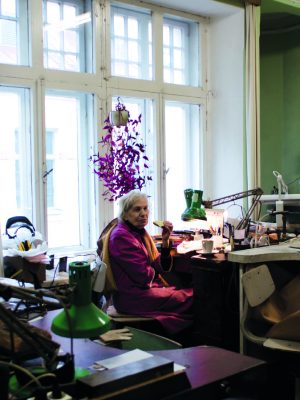
‘I will not use a material that mimics something else. I will only use an original.’
Colorlessness
Inside the school we are looking at the wall of student’s work, contained in glass boxes. Mostly metal, very intricate, labour intensive pieces, very detailed and refined. Black and grey. Mostly grey. The colorlessness is a part of the local identity. But it is not about intentional absence of colour, it is about the natural colour of the material. And the material is natural in almost in every case. In 2012 Rainer Kaasik-Aaslav carved a decorative egg titled ‘Circle Dance’, depicting three dancing men, with hands around each other’s shoulders. While carving a speckled whitish moss opal, he stumbled upon another stone that was growing inside of it – a lighter, softer kind. This discovery led him to carve a figure of a child and keep it inside the object. He comments: ‘I will not use a material that mimics something else. I will only use an original. Natural material is like a partner, it’s moving all the time. You can’t know in advance what will happen to the piece. Material has a certain essence in itself. Quality, that plastic does not possess. Carving a stone and finding another stone being born inside can only happen when you use something living.’ – We are sitting in the atelier of 4/6 of Õhuloss – Castle in the Air collective and drinking tea with Piret Hirv. She is one of the members, as well as a teacher at the Academy. ‘… Metals are quite colourless. Iron, silver… they are, so we encourage students to go inside the material, to find out its qualities, to understand these qualities first and then they can go on trying different things. But the point is – using different materials does not signify quality in itself.’ Piret is a delightful person. She is very deep in her thoughts and very careful in her words. ‘Silver gives nice white colour. But I don’t like the oxidation. All white. Actually, I would say: colourless. The title the work Afterstorm opens up the meaning. It’s the calmness after the storm at sea. It’s the windless condition after the storm. There is no good word in English for it. In Estonian it’s tuulevaikus. There is another piece called After rain. It’s when everything is wet and pressed down. It’s the silence before another strike begins.’
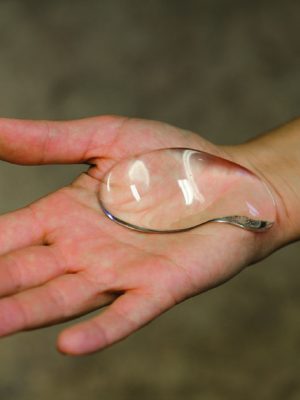
Silence
When asked what makes your work Estonian, Piret said: ‘Silence. Inside ourselves. We are silent people. In nature there is silence.’ ‘Jewellery is an art form, along the lines of music, painting, sculpture, theatre, etc. You cannot call jewellery an applied art, because its application is not purely functional like that of a ceramic pot. The function is emotional and very intimate. And it’s worth something. Emotional function means you don’t have to wear it, or it doesn’t have to be an object with a pin… It functions for our senses. Jewellery is an investment in emotion.’ Famous Estonian composer Arvo Pärt recorded his famous Tabula Rasa back in September 1977 in one of the Tallinn’s churches at four o’clock in the morning. One of the main features of Pärt’s style was his ability to articulate silence. The piece consists of considerable silences, and the sound of silence is what he was trying to capture.
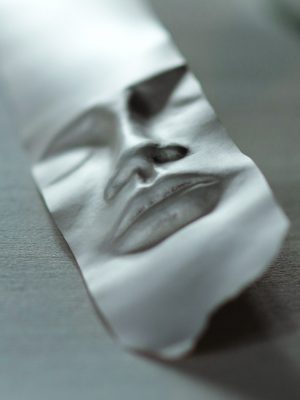
Darkness
‘Do you know about kaamos (polar night – Finnish)? It gets really dark here. No sun for eight months a year. November is so rainy, and, of course, there is sun behind the clouds… but already starting in September it gets dark around 6 p.m.’ – Kristiina Laurits is another member of Õhuloss. She is interested in objects of status and luxury. I notice beautiful lacquered brooches, painstakingly decorated with precious metals and stones. This reddish black glossy material is animal liver. ‘I find liver as a material very interesting because liver is a very symbolic organ. For ancient people liver represented an organ that contained all dark emotions: jealousy, anger, etc. It is a very mythical organ, and a very emotional organ. I made it darker, covering it with lacquer. I decorate it and I make a jewel out of it, so people can put their negative emotions into the piece, rather then into their own liver.’ In many ways Kristiina’s work deals with decoration of a simple non-precious material and through that process she eventually creates an object of desire. She made beautiful work with dried pieces of brown bread, set with precious stones and covered with gold leaf. Once again, she lifts the value of the bread and it’s meaning in times of war or hunger. A piece of jewellery, being the last in the line of goods and the ‘daily bread’ being the first – merge into one in her work. ‘I like contrasts: like liver and stone, or piece of bread with gold and emeralds. There is preciousness that is universally recognized. And bread is very precious, maybe not as a material for jewellery, but for a human being in general. Estonia is a poor country, we do not have history of gold production, like Etruscans in Italy, and in our mountains we don’t have precious or semi-precious stones. So, in a way, we mentally allow ourselves to be open to what surrounds us, wood, salt, animal originated materials.’ Being surrounded by forests, many people have country houses where they grow their own food and often have animals as well. Closeness to nature makes their understanding of materials of animal origin quite the opposite to the conventional: not disgusting, but beautiful. The closeness of the forest is unbelievable. We are driving through Tallinn with Annika Kedelauk and Rainer Kaasik-Aaslav 2/3 members of the OTSE collective. Approaching the Northern part of the city we see how forest intertwines with human dwellings. People are coming in and out of it, jogging, walking their dogs, and for a second one might think it’s a city park, but looking deeper between tree trunks one sees a lurking pitch-black thick forest. I see the water and ask Annika to stop the car. I want to have a look at it. I walk to the shore, covering myself with an umbrella. It’s still raining. On the shore, I see how the grey wet asphalt enters the dusky grey water, which in turn transforms into the grey gloomy sky. There is almost no way to tell the difference. It’s our second day in Tallinn.
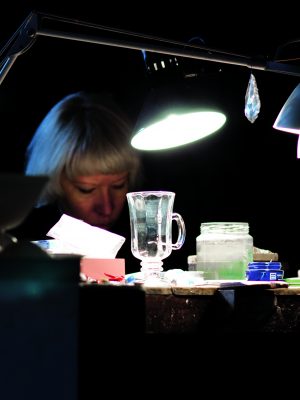
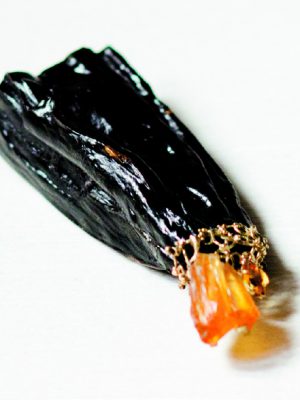
Blackness
– Black is your favorite colour? Or mood? – Yeah, mood I have been in black since I was born We are meeting Kadri Mälk around 1 a.m. at her home. There has just been a storming rain and in a matter of minutes old city center is flooded knee-high by muddy black water. Kadri’s house in quiet and dusky. We sit and listen. She talks about becoming the head of the metal department: the story of a young professor, too young in fact, but chosen by her predecessor Leili Kuldkepp. It’s a journey full of struggles and hardships. She refers to it as ‘missionary work’.
People like her are natural leaders, destined to become powerful figures, retaining not just ‘earthly’ credentials, but mainly a complex position of being a spiritual leader. A shaman is not just someone in contact with the ‘other side’, a transmitter of the will and order, imposed on us by higher powers, but also an influential member of the society – a mediator for those who want to get in contact with the pre existing environment. Kadri Mälk is a true shaman, and in this way she resembles Joseph Beuys and his teachings on energizing our spirituality and combining it with our thinking: ‘Our vision of the world must be extended to encompass all the invisible energies with which we have lost contact.’ He believed that the ‘enchanter’ must appear in places of rational thinking to distract from rationalizing, thus destroying emotions and creativity. Mälk took the position of a teacher, who not only helped to give form to Estonian contemporary jewellery, but also pointed out its gravitational centers and supplied the newcomers with endless re-telling of the story. There needs to be a solid story, so a stranger can begin to understand. At first, her words and writings seemed too airy, intangible, like chasing something in the middle of a pitch-black night: it seems like you are almost grasping it, but when you open the palm of your hand – the only thing there is your cold sweat. But understanding the commonplace, confiding with the existing, agreeing with the proven is not where art begins. It begins outside boundaries.
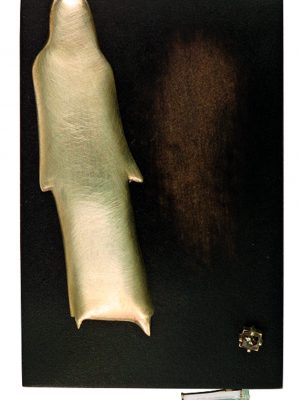
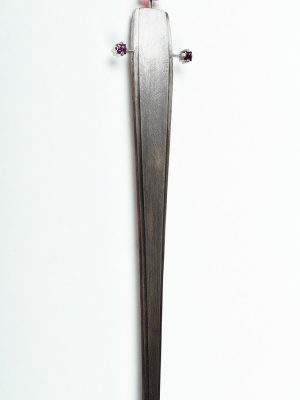
‘Jewellery belongs to the spirit, and that is why the function of being worn is not a prime one.’
Mälk: ‘After all, it is not essential to see what has not been seen before, but to think differently about what everybody sees. Expressed in unusual enigmatic after iconography.’ Kadri Mälk finds significance in depth of both matter and energy. She seeks the materials that contain spiritual power. She knows physical qualities of stones and metals, but speaks of them in her own way. For example she calls a jet ‘stone that experienced life’ and therefore she finds its dust precious. She compares coral to human skin and thinks of facet cutting as an accumulation of circumstances. Jewellery belongs to the spirit, and that is why the function of being worn is not a prime one. Nevertheless, jewellery helps us to connect to a comfort zone, transform our thoughts in another direction, make us feel safe and keep remembering… How many times a day you touch your wedding ring or a pendant without even noticing?
Luminance
Our meeting with Tanel Veenre took about three night hours. Despite the fact that his work was one of the reasons we wanted to come up to Tallinn, his personality and vision go far beyond expectations. He is intensely charged with an intoxicating mix of carnal and spiritual energies: ‘The abundance of energy always comes up in my conversations with people. I sleep seven hours a day and can work 16 hours straight for years. But don’t look at it as sacrifice or heroic deed, it still pure egoistic fun. I am just this bad in resting!’ Tanel Veenre might rightfully be considered one of the most well-known Estonian contemporary jewellery artists of today. We asked him how does he feel about his success: ‘I don’t have that feeling. Exhibitions and proposals are happening a lot, but our world is small and after all it doesn’t matter if you are famous in your street, in your town or in the world. It’s just stretching the scale a little bit. Everything is a moment and then it’s over. The End. I’m constantly thinking about that, looking at things from a big prospective, thinking about eternity and death and these sorts of things. So, somehow I’m not so concerned about being known somewhere now. Of course, those are nice moments, touching contacts between two human beings, but in the evening I feel like all is so small on the scale of eternity.’
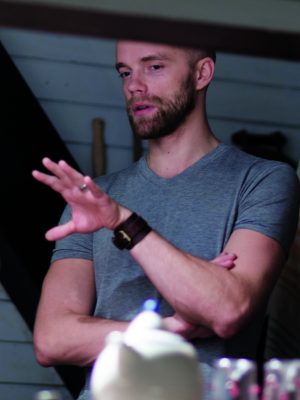
Tanel about the future ‘I think art history will be re-written and it will happen quite soon. We find ourselves in a very decadent era. I made my Master Thesis based on a ‘triangle of everything’ :morning-day-evening, childhood-fertility-dying… All the known cultures went through this triangle. They start somewhere, they have their peak and then they die. We are a dying culture in this sense. I think the Christian culture, which counts over 2000 years, the European culture is dying, obviously. And I feel like celebrating the sunset with rose in the buttonhole, with pride and dignity. So there will be something new. That is why I’m always directed towards the future, my biggest inspiration is the future. It is kind of a mind game – how much I can predict and even influence the future?’
Tanel about quality vs. influence ‘I try to achieve a certain level of quality that would still be considered precious in 10 years time, regardless of the actual material value. In my opinion, what makes you stop feeling related to the old work is superficiality, influences of which you were unware at the time, but you see them when you look back.’
Tanel about style ‘Few years ago I got this idea, that I would really like to get rid of ‘the style’. It bothers me that in contemporary jewellery field almost everyone works in series. I find this notion very artificial, almost like in fashion business. Often the pressure comes from the galleries. It’s about becoming known and remembered for a certain style that is becoming a trademark, a product. So, in my work, I really want to be able to make U-turns (from fashion to installation, from photo to design, from delicate organic carvings to huge mathematical constructions), and a viewer would not be able to guess that the same person made them. I find that very intriguing. Galleries are the System. You have to comply with expectations, but I do not work like that. I do not like linear thinking. Isn’t it most boring if you can see all the intentions of the creator? I’m distancing myself from the notion of ‘constructing’ the work. It is similar to the idea of working in series. Loads of conceptual art in general ends up in some sort of ‘construction’. And it is not convincing. It is a result of a certain way of thinking. I feel that my approach is much more intuitive, but the work itself remains conceptual. The concept is a selfpreparation, it`s about trusting my own body and my ideas, but the thing is, they are still only fragments, until the work is done, somehow. And then I just look back and see the whole story coming together with all it`s significance and still open ends. I feel like it all should be here before. It might sound a bit creepy, but aren’t artists just mediators? All things are already here as ideas, but artist’s role is just to release them into the physical world. It works subconsciously and quite often my work is built this way. It’s a result of freedom I give myself. Often I don’t know what is behind certain pieces. There is a lot of switching between scales, materials, technologies, etc. What I feel is a great urge, high pressure inside. Human beings, art pieces and diamonds are formed in their inner pressure and heat. So I am just digging and digging deep…It’s a huge process, like a river and I’m in this river and I just follow my instincts. I don’t need any mediation to get myself to certain a point. I’m all the time at that exploding point! (laughing) I’m constantly there! It’s the only way I know.’
And yes, we always wanted to know about the mysterious cosmic dust and how it ends up covering his pieces in gentle gradients of colour – he smiled and showed us a tea strainer…
This article was first published in #1 The Archetype Issue, 2013
